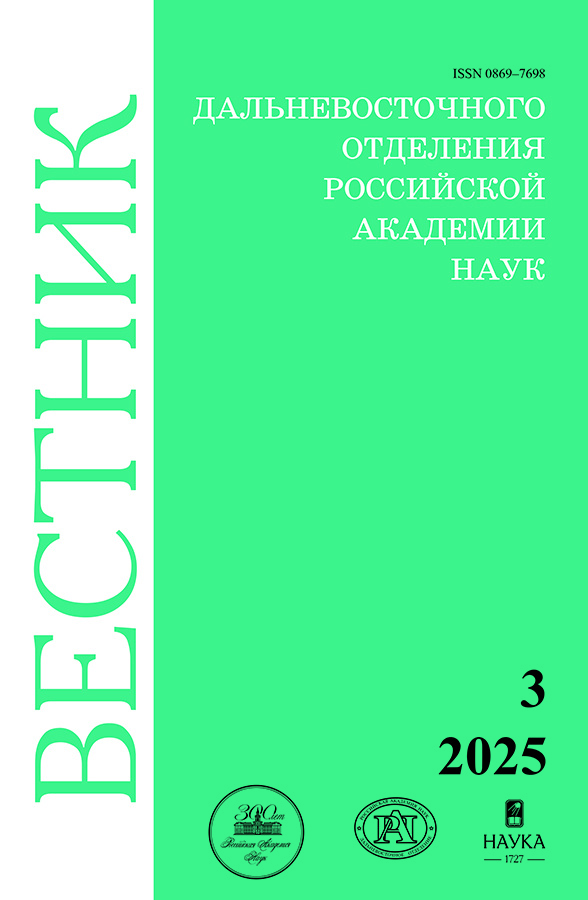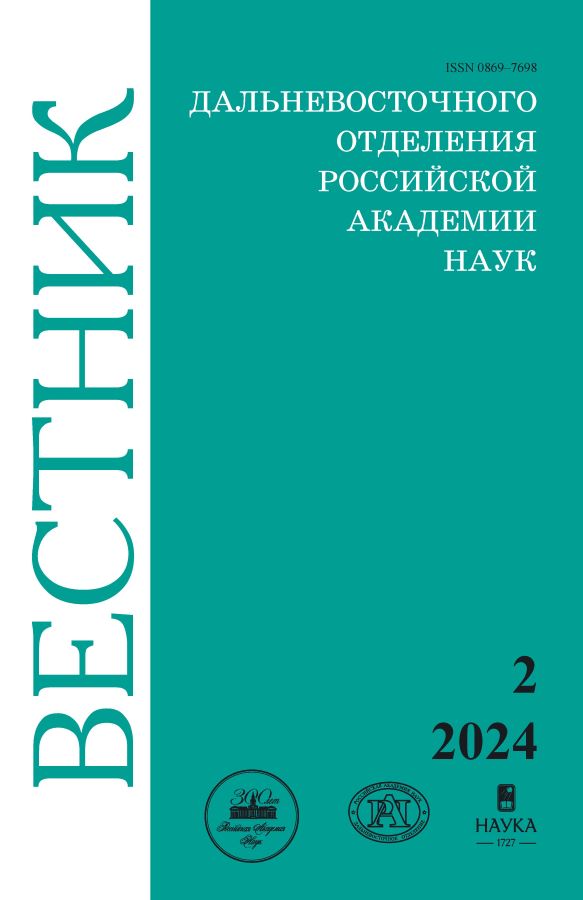INDEL-typing of strains of parahemolytic vibrions in vitro and in silico
- Authors: Chemisova O.S.1, Tsyrulina O.A.2, Vodopyanov A.S.2, Vodopyanov S.O.3, Sagakyants M.M.3
-
Affiliations:
- Don State Technical University
- The Federal Government Health Institution Rostov-on-Don Plague Control Research Institute of the Federal Service for Surveillance in the Sphere of Consumers Rights
- The Federal Government Health Institution Rostov-on-Don Plague Control Researsh Institute of the Federal Service for Surveillance in the Sphere of Consumers Rights
- Issue: No 2 (2024)
- Pages: 80-89
- Section: Biological Sciences
- URL: https://archivog.com/0869-7698/article/view/676051
- DOI: https://doi.org/10.31857/S0869769824020089
- EDN: https://elibrary.ru/lddwqt
- ID: 676051
Cite item
Full Text
Abstract
The article presents the results of studying the distribution of Vibrio parahaemolyticus INDEL genotypes in the world and in Russia in vitro and in silico using the previously developed INDEL typing method based on the distribution of alleles of six loci (Vp967, Vp08, Vp619, Vp2256, VpA472, and Vp506). Among 2105 strains of V. parahaemolyticus taken in the study, 30 unique INDEL genotypes were identified, seven of which were identified as major. At the same time, geographical attachment between the genotype of parahaemolytic vibrions and the place of their isolation was revealed. The circulation of 17 INDEL genotypes was detected on the territory of the Russian Federation, the predominant of which was D2, found only in the Russian Federation. As a result, it was found that the proposed INDEL-typing method is a useful tool in conducting epidemiological investigations, which makes it possible to identify phylogenetic relationships between different isolates, which in turn makes it possible to draw conclusions about the sources of splinters of the pathogen to a specific territory.
Full Text
About the authors
Olga S. Chemisova
Don State Technical University
Email: chemisova@inbox.ru
ORCID iD: 0000-0002-4059-2878
Candidate of Sciences in Biology, Associate Professor
Russian Federation, Rostov-on-DonOksana A. Tsyrulina
The Federal Government Health Institution Rostov-on-Don Plague Control Research Institute of the Federal Service for Surveillance in the Sphere of Consumers Rights
Email: rykowskaya.oxana@yandex.ru
ORCID iD: 0000-0001-6176-2605
Candidate of Sciences in Biology, Senior Researcher
Russian Federation, Rostov-on-DonAleksey S. Vodopyanov
The Federal Government Health Institution Rostov-on-Don Plague Control Research Institute of the Federal Service for Surveillance in the Sphere of Consumers Rights
Email: alexvod@gmail.com
ORCID iD: 0000-0002-9056-3231
Candidate of Sciences in Medicine, Senior Researcher
Russian Federation, Rostov-on-DonSergey O. Vodopyanov
The Federal Government Health Institution Rostov-on-Don Plague Control Researsh Institute of the Federal Service for Surveillance in the Sphere of Consumers Rights
Email: serge100v@gmail.com
ORCID iD: 0000-0003-4336-0439
Doctor of Sciences in Medicine, Leading Researcher
Russian Federation, Rostov-on-DonMargarita M. Sagakyants
The Federal Government Health Institution Rostov-on-Don Plague Control Researsh Institute of the Federal Service for Surveillance in the Sphere of Consumers Rights
Author for correspondence.
Email: margsagak@rambler.ru
ORCID iD: 0000-0001-8235-3288
Researcher
Russian Federation, Rostov-on-DonReferences
- Wang R.Z., Huang J.D., Zhang W. et al. Detection and identification of Vibrio parahaemolyticus by multiplex PCR and DNA-DNA hybridization on a microarray. Journal of Genetics and Genomics. 2011;38:129-135. doi: 10.1016/j.jgg.2011.02.002.
- Broberg C.A., Calder T.J., Orth K. Vibrio parahaemolyticus cell biology and pathogenicity determinants. Microbes and Infection. 2011;13:992-1001. doi: 10.1016/j.micinf.2011.06.013.
- Zhang L., Orth K. Virulence determinants for Vibrio parahaemolyticus infection. Current Opinion in Microbiology. 2013;16(1):70-77. doi: 10.1016/j.mib.2013.02.002.
- Nair G.B., Ramamurthy T., Bhattacharya S.K. et al. Global dissemination of Vibrio parahaemolyticus serotype O3:K6 and its serovariants. Clinical Microbiology Reviews. 2007;20(1):39-48. doi: 10.1128/CMR.00025-06.
- Yeung P.S., Boor K.J. Epidemiology, pathogenesis, and prevention of foodborne Vibrio parahaemolyticus infections. Foodborne Pathogens and Disease. 2004;1:74-88. doi: 10.1089/153531404323143594.
- Velazquez-Roman J., Leоn-Sicairos N., Hernаndez-Diaz L., Canizalez-Roman A. Pandemic Vibrio parahaemolyticus O3:K6 on the American continent. Frontiers in Cellular and Infection Microbiology. 2013;3:110. doi: 10.3389/fcimb.2013.00110.
- Maslov D.V. Vspyshka galofileza sredi naseleniya goroda Vladivostoka Primorskogo kraya = [An outbreak of halophilosis among the population of the city of Vladivostok, Primorsky Krai]. Public Health and Life Environment. 1997;57(12):17-21. (In Russ.).
- Lomov Yu.M., Kudryakova T.A., Makedonova L.D. et al. Galofil’nye vibriony, obuslovivshie vspyshku pishchevoj toksikoinfekcii vo Vladivostoke = [Halophilic vibrions that caused the outbreak of food toxicoinfection in Vladivostok]. Journal of Microbiology, Epidemiology and Immunobiology. 2001;(6):3-7. (In Russ.).
- Rykovskaya O.A., Mazruho A.B., Smolikova L.M., Monahova E.V., Chemisova O.S., Podojnicyna O.A. et al. Vibrio parahaemolyticus serogruppy O3:K6 – vozbuditel’ vspyshek pishchevoj toksikoinfekcii v Primorskom krae Rossijskoj Federacii = [Vibrio parahaemolyticus of serogroup O3:K6 is the causative agent of outbreaks of food toxicoinfection in the Primorsky Territory of the Russian Federation]. Journal of Microbiology, Epidemiology and Immunology. 2013;(4):57-61. (In Russ.).
- Vodopyanov A.S., Vodopyanov S.O., Olejnikov I.P., Mishankin B.N. INDEL-genotyping of vibrio cholerae strains. Epidemiology and Infectious Diseases. 2017;22(4):195-200. (In Russ.). doi: 10.18821/1560-9529-2017-22-4-195-200.
- Liu F., Hu Y., Wang Q. et al. Comparative genomic analysis of Mycobacterium tuberculosis clinical isolates. BMC Genomics. 2014;15(1):469. doi: 10.1186/1471-2164-15-469.
- Larsson P., Svensson K., Karlsson L. Canonical Insertion-Deletion markers for rapid DNA typing of Francisella tularensis. Emerging Infectious Diseases. 2007;13(11):1725-1732. doi: 10.3201/eid1311.070603.
- Chemisova O.S., Vodopyanov A.S., Rykovskaya O.A. et al. Molecular typing of the Vibrio parahaemolyticus strains by INDEL markers. Infectious Diseases. 2018;7(3):26-30. (In Russ.). doi: 10.24411/2305-3496-2018-13004.
- Mishan’kin B.N., Vodop’yanov A.S., LomovYu.M. Mul’tilokusnoe VNTR-tipirovanie kul’tur holernyh vibrionov, vydelennyh v g. Kazan’ vo vremya vspyshki holery letom 2001 goda = [Multilocus VNTRgenotyping of the cultures of Vibrio cholerae isolated in Kazan the outbreak of cholera in summer of 2001]. Journal of Microbiology, Epidemiology and Immunology. 2003;(6):11-15. (In Russ.).
- Tamura K., Peterson D., Peterson N., Stecher G., Nei M., Kumar S. MEGA5: Molecular evolutionary genetics analysis using maximum likelihood, evolutionary distance, and maximum parsimony methods. Molecular Biology and Evolution. 2011;28:2731-2739.
- Xiao Chen, Qiaoyun Zhu, Fei Yu, Wen Zhang et al. Serology, virulence and molecular characteristics of Vibrio parahaemolyticus isolated from seafood in Zhejiang province. PLOS One. 2018;13(10). e0204892. doi: 10.1371/journal.pone.0204892.
- Scallan E., Hoekstra R.M., Angulo F.J. et al. Foodborne Illness Acquired in the United States-Major Pathogens. Emerging Infectious Dieseases. 2011;17:7-15. doi: 10.3201/eid1701.P11101.
- Martinez-Urtaza J., Huapaya B., Gavilan R.G. et al. Emergence of Asiatic Vibrio diseases in South America in phase with El Niño. Epidemiology. 2008;19(6):829-837. doi: 10.1097/EDE.0b013e3181883d43.
- Martinez-Urtaza J., Baker-Austin C., Jones J.L. et al. Spread of Pacific Northwest Vibrio parahaemolyticus. New England Journal of Medicine. 2013;369:1573-1574. DOI: 10.1056 /NEJMc1305535.
- Kaneko T., Colwell R.R. Ecology of Vibrio parahaemolyticus in Chesapeake Bay. Journal of Bacteriology. 1973;113(1):24-32. doi: 10.1128/jb.113.1.24-32.1973.
- Buzoleva L.S., Letyagina A.V., Zvyagincev A.Yu., Kashin I.A. Investigation of microorganisms entering the port of Vladivostok with ballast waters of ships. Russian Journal of Biological Invasions. 2012;5(1):19-31. (In Russ.).
- Vodyanitskaya S.Yu., Prometnoy V.I., Telesmanich N.R., Ryzhkov Yu.V., Lyakh O.V., Trut I.V., Ivanova N.G., Kruglikov V.D., Chemisova O.S. Results of the triennial monitoring over the ship’s ballast water at the ports of the Rostov Region. Problems of Particularly Dangerous Infections. 2014;(2):108-110. (In Russ.). DOI.: 10.21055/0370-1069-2014-2-108-110.
Supplementary files







